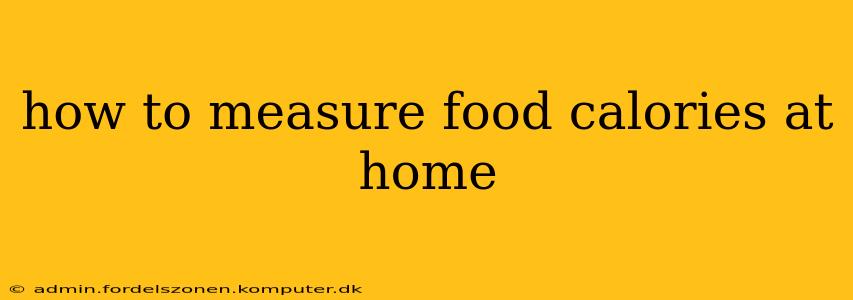Accurately measuring food calories at home can be challenging, but it's a crucial step in managing your weight and overall health. This guide provides practical strategies and tips to help you estimate and track your daily calorie intake effectively. We'll explore various methods, address common questions, and offer advice for achieving your health goals.
Why is Measuring Food Calories Important?
Understanding your caloric intake allows you to make informed decisions about your diet. Whether you aim to lose, maintain, or gain weight, knowing your calorie consumption is fundamental. Consistent tracking helps build awareness of portion sizes and the caloric density of different foods. This knowledge empowers you to make healthier food choices and achieve your fitness objectives.
How to Measure Food Calories at Home: Methods and Tools
Several methods can help you estimate food calories at home, each with its own level of precision.
1. Using a Food Scale and Nutrition Labels
This is the most accurate method. A kitchen food scale allows you to weigh your food precisely, enabling you to use the nutrition information on the packaging to calculate your calorie intake. This approach is particularly effective for packaged foods with clear nutritional labeling. Remember to pay close attention to serving sizes listed on the label.
Example: If a package of crackers states that one serving (30 grams) contains 150 calories, and you eat 60 grams, you've consumed 300 calories (150 calories/serving * 2 servings).
2. Utilizing Calorie Counting Apps and Websites
Many mobile apps and websites (like MyFitnessPal, Lose It!, Cronometer) offer vast food databases. You can search for specific foods and enter the amount you consumed. These apps often integrate with barcode scanners, making data entry quick and efficient. However, remember that the accuracy relies on the information provided in the database and the accuracy of your input.
3. Estimating Calories Based on Visual Cues and Portion Sizes
This method is less precise but valuable when you don't have access to nutrition labels or apps. It involves learning to visually estimate portion sizes (e.g., a fist-sized portion of cooked vegetables, a deck of cards for meat). While less accurate, it's a useful tool for developing a general understanding of portion control.
4. Using Calorie Counting Books and Charts
These resources offer estimations for various foods and recipes. While they may lack the granularity of apps, they provide a helpful guideline, especially for those who prefer a less technologically driven approach.
What are some common challenges in measuring food calories at home?
H2: How accurate are calorie counting apps?
Calorie counting apps are generally reliable, but their accuracy depends on the data they use. Some databases might be more comprehensive and updated than others. Also, the accuracy is heavily dependent on how accurately you enter your food intake. Always double-check the information and be as precise as possible with serving sizes.
H2: How can I measure calories in homemade meals?
Measuring calories in homemade meals requires a more involved approach. You'll need to track the calories of each ingredient using nutrition labels or online databases and add them together. Recipes often provide nutritional information, but it’s always a good idea to double-check. If you’re uncertain about a specific ingredient, an online search or a nutrition database can help.
H2: What if I eat out frequently?
Eating out poses a challenge as precise calorie information isn't always available. Many restaurant websites or apps now provide nutritional information, but it's still often an estimate. When in doubt, it’s wise to err on the side of caution and slightly overestimate the calorie count.
Tips for Accurate Calorie Measurement
- Weigh your food, don't guess: This is the most accurate method.
- Read labels carefully: Pay close attention to serving sizes.
- Use measuring cups and spoons consistently: Avoid eyeballing portion sizes.
- Be honest with yourself: Don't underestimate or overestimate your intake.
- Start small and gradually improve your accuracy: Don't get overwhelmed; focus on making progress over time.
- Track your progress: Note what works well and identify areas for improvement in your calorie tracking.
By combining these methods and strategies, you can develop a system for accurately measuring food calories at home, supporting your health and wellness journey. Remember, consistency is key. The more you practice, the more adept you'll become at estimating and tracking your daily calorie intake.
